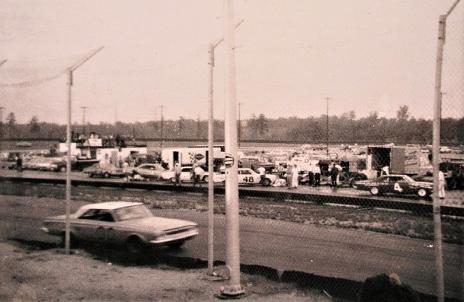BELTSVILLE SPEEDWAY - BELTSVILLE MD
(Baltimore - Washington Speedway)

The Beltsville Speedway was a ½ mile NASCAR asphalt oval track in the American community of Beltsville, Maryland. It was specially designed with banked turns for stock car racing. Originally known as the Baltimore-Washington Speedway, this track would receive its final name in its 19th month of operation. The track has hosted modified stock car racing vehicles alongside the other NASCAR series. Wednesday nights were the original night for racing but the schedule eventually added Friday night racing. Ten Grand National races were raced here including the popular Beltsville 300 series of races. The first Cup race was in 1965. Ned Jarrett started on the front row and would lead all 200 laps to claim the win. Tiny Lund finished second two laps back. From 1966-1969 the track hosted two Cup races
each year. The Spring race saw Tiny Lund just edge out James Hylton by a distance of about two feet to get the win. In the Fall, Bobby Allison bested Elmo Langley by more than a lap. In the Spring of 1967, Jim Paschal was able to outrun Richard Petty by five seconds to claim the Victory. When the Cup Series returned in the Fall of '67 the race distance had been increased to 300 laps. This time Petty did manage to get the win as he whipped the field, leading 171 laps and winning by over two laps. In 1968, David Pearson won becoming the sixth different winner in six races as he beat Bobby Isaac. That Fall saw Isaac get the win as he became the seventh different winner. Isaac became the dominate driver from 1968 until the track ran it last Cup race in 1970. He won again in 1969 and again in the tracks final race in 1970. The only race he didn't win was in the Fall of 1969; but he was leading when he crashed out. The track also ran NASCAR Modifieds in 1965-1967, and switched to NASCAR Late Model Sportsman in 1968 and ran them until closing in 1978. Held 10 Cup races. Strict noise restrictions were given out in its final year of racing and the county (Prince George's County) starting monitoring the events. Eventually, a sound wall was built surrounding the speedways. Cars had to begin running mufflers in order to stifle the noise from the increasing RPMs from the vehicles themselves. The track was eventually shut down, demolished, and replaced with a local community college.
All Photos copyright and are property of their respective owners
